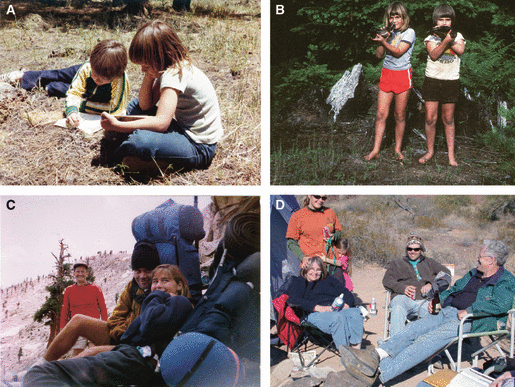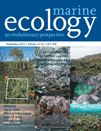Observations in nature: the keystone to understanding natural systems
‘Let it float down through the ripple and have the eddy swing it behind the rock.’ We were 4 and 5 years old and knew how to see an eddy and use the current of the stream to deliver a hooked grasshopper to a lurking trout. Little did we know we were in fact working through the first steps of the scientific method.
Regardless of specific discipline or expertise, by the time students reach the end of their undergraduate academic journey they have likely been taught the ‘scientific method’ in detail, at least a half a dozen times inside a classroom. By and large it is included in curricula at the elementary, middle-school, and high-school levels and is taught to undergraduates in introductory biology courses and then hit upon again numerous times in upper-division courses for science majors. Yet students are too frequently not provided an opportunity to actually implement the scientific method (i.e. to actively observe, hypothesize, design, implement, summarize, discuss, and disseminate results) as a ‘hands on’ and complete experience. Although exposing students to the scientific method in its entirety and providing more opportunities to take courses that focus on field methods, organisms, and natural history in general are (in our opinion) greatly needed, here we would like to discuss the first step of the scientific method, ‘Observation’, and highlight its importance and how it has shaped Paul Dayton’s career and more specifically the careers and, at least in our cases, the lives of those that he has mentored. As his two children, we provide a somewhat unique perspective.
In scientific endeavors luck rarely plays a reoccurring or significant role. Rather, it is observation of patterns in nature, behavior, life histories, molecular makeup, etc., that spawns curiosity, which in turn leads to questions and a quest to find answers. To decipher nature in a meaningful way, one needs to spend time in nature. Paul grew up bouncing between logging camps in the Pacific Northwest, later living in the Sonoran Desert in Tucson, Arizona, and camping extensively in these areas and in Mexico. Throughout his childhood he was immersed in nature and gained a thorough understanding of his immediate surroundings. The desire to explore was instilled by his parents who, largely because of frequent spells of unemployment, spent several weeks of the year on family camping trips. Exploration of his many ‘backyards’ (coniferous forests, alpine habitats, and the southwestern deserts), diving forays, and volunteering with archaeological studies in Alaska as a teenager provided opportunities to observe and to question. Importantly, he was surrounded by community and family who taught him about nature and provided answers to his questions. These early experiences and lessons learned from family and friends undoubtedly influenced Paul’s ability to observe, decipher, and appreciate nature.
Throughout his life, Paul has observed nature, with an apparently innate ability to see patterns. His keen observational skills provide the foundation for his expansive body of scientific research, which in turn has had profound impacts on ecology, conservation, and science in general. Citations, awards, and other accolades aside, we would argue that perhaps his biggest impact on science and society has been his ability to inspire people about science through teaching the art of observation of nature in nature, and, in turn, stimulating them to think deeply about what they are seeing.
As children, we too spent a significant amount of time in nature and camping around the southwestern and Pacific Northwest regions of the United States and in Baja California (Fig. 1). We walked around with magnifying glasses in our pockets and a sense of our smallness in a larger world in our minds. Through our own experience in the company of our father, we learned to observe the bigger pictures, the tides, the weather patterns, the layers of ancient earth – each with its own story of how the world was then. We were also taught to appreciate the smaller details of the world around us –‘Put your hand down on the ground – how many species are you touching?’‘Close your eyes and listen until I get back. How many different creatures did you hear?’ For us, plants in the surrounding landscape were not just green blobs, rather they were different shades of green in specific locations, often predictable, throughout the landscape. Each plant was both an independent entity, curling and uncurling its leaves with changes in weather, and a part of a larger pattern, a nitrogen fixer or a source of shade. Eddies in creeks and rivers were predictably located along banks and bends or in areas with obstructions or significant drops in elevation. These eddies captured floating invertebrates that in turn were fed upon by trout. Lichens are common on the rocks in some small valleys in Baja California but are hard to find in seemingly similar areas only a short distance away. The same lichen patches may not look very different from year to year, but when pictures are compared over decades, one can begin to see whether patterns change. Foxtail pines at elevations above approximately 10,500 feet in many areas of the Southern Sierras are large and presumably very ancient, yet there are very few seedlings. Jumping cholla balls don’t produce seeds, but do have barbed spines, release easily from the adult plant, and later drill roots into the ground where they are shed or eventually come to rest. Horned lizards blend in with their environment. Dirt smells distinctly different depending upon where you are and how wet or dry it is. These were patterns and perspectives that were introduced to us by our father. There was often speculation about the mechanism responsible for the pattern, some arm waving, and some guessing. Sometimes we agreed with the proposed hypotheses; other times, we were motivated to find the answers for ourselves, through research or through experimentation. Essentially we were being trained to observe nature and think about what we were seeing and, indirectly, think about the processes that might lead to the patterns.

Camping has always been an important part of our lives. (A) Spending time reading and writing while camping. (B) A successful fishing endeavor. (C) Paul with his children in the High Sierras. (D) Three generations in the Pinacate Desert, Mexico – left to right, Linnea, Anaika, Savanna, Gage, and Paul.
It was not until much later that each of us realized that observing nature, discerning patterns, and thinking about the mechanisms that shape them was not second nature for most people. This skill or art, in fact, was something that we had been taught through experiential learning in the field as children by our parents. Paul’s own keen sense of observation has led to hundreds of hypotheses, several of which have resulted in significant contributions to science. Many more of his observations have simply stimulated thought and discussion among students, peers, and friends. Through his teaching of undergraduate and graduate students, Paul has directly taught hundreds of people how to observe, wonder, appreciate, and hypothesize. Many of these observations have been the catalyst for successful graduate and professional careers, and many of the people he has taught or influenced have gone on to have successful scientific careers in academia, state and federal agencies, and nongovernmental organizations; many others have gone on to other careers outside of science and have carried this appreciation of nature into a multitude of fields. Regardless of where people have ended up, Paul’s passion for science, firmly rooted in observation, has exposed people to nature and taught them to observe and think deeply about potential mechanisms responsible for the patterns they are seeing. Those of us who have been mentored by Paul have an appreciation and understanding of the intricacies of nature and, as a direct result of his mentorship, have (collectively) gone on to train thousands of students, friends, or community and family members (formally or informally) to observe, question, and appreciate. We would bet a pie that this statistic is perhaps the one that instills the greatest sense of pride and accomplishment in our father when he ponders the impact of his career.




